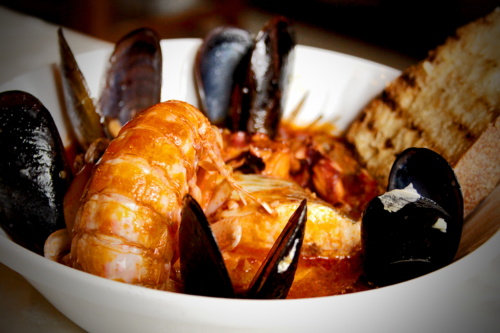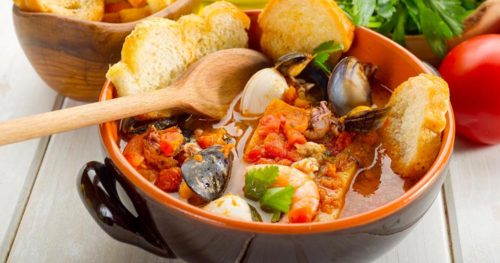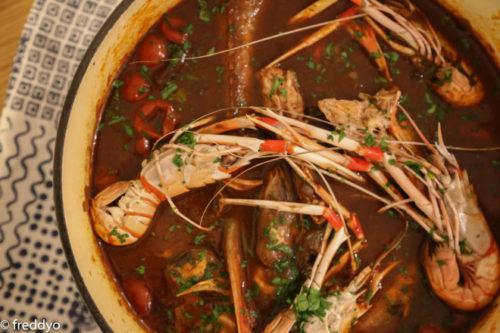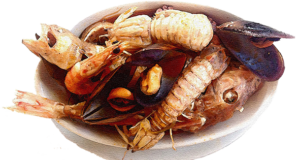Cacciucco is a hearty Italian fish stew known to the western coastal towns of Tuscany and Liguria for over 500 years. It is especially associated with the Tuscan port city of Livorno and the town of Viareggio to the north.

The term ‘Cacciucco’ derives from a Turkish word Kϋçϋk (“small” or “bits and pieces” or “odds and ends”), which refers to the size and variety of the fish used to make the dish. Originally, Cacciucco was made with those fish left over after a catch, the pesce povero or “poor fish” because they were more difficult to sell and often taken home at the end of the day by the fisherman for his family.
It is a stew or soup consisting of several different types of fish and shellfish. According to one tradition, there should be five different types of fish in the soup, one for each letter C in Cacciucco. A wide variety of Mediterranean fish and shellfish may be used, such as octopus, squid, and bony fish like scorfano nero (black scorpion fish), pesce prete (Atlantic stargazer), gallinella (tub gurnard), palombo (dog fish), and tracina (weever fish), small clams (littleneck or manila), mussels, shrimp, calamari, mantis prawns crabs, eel, cuttlefish, octopus, bream, mullet, or anything else caught that day. The soup is made with tomato, garlic, chili, red wine and often fresh sage.

Cacciucco is similar to other types of fish stew, such as the French bouillabaisse, Greek kakavia, Spanish zarzuela, and Portuguese caldeirada. Cioppino, another fish stew, was created by Italian-American fisherman in San Francisco, who used the local Dungeness crab in a variation of the Cacciucco recipe.
There are many legends and myths surrounding its creation although there are two stories most often repeated. The first tells of a fisherman from Livorno who lost his life at sea in a shipwreck. His children were so hungry with nobody to provide for them after his death that they turned to all their neighbors for food. Everyone gave them different types of fish (similar to the story of Acquacotta), with which their mother made a huge soup adding tomatoes, garlic, oil and slices of bread – thus creating the first cacciucco.

The second, is that a lighthouse keeper created the soup. The Florentine Republic had prohibited the use of the olive oil that he always used to fry his fish and so instead of his favorite pesci fritti, he made a fish soup instead.
Pellegrino Artusi, in his classic 1891 cookbook cookbook La scienza in cucina e l’arte di mangiar bene (The Science of Cooking and the Art of Fine Dining), created the following recipe:
For 700 grams (1 1⁄2 lb) of fish, finely chop an onion and sauté it with oil, parsley, and two whole cloves of garlic. The moment the onion starts to brown, add 300 grams (10 1⁄2 ounces) of chopped from tomatoes or tomato paste, and season with salt and pepper.

When the tomatoes are cooked, pour in one finger of strong vinegar or two fingers of weak vinegar, diluted in a large glass of water. Let boil for a few more minutes, then discard the garlic and strain the rest of the ingredients, pressing hard against the mesh. Put the strained sauce back on the fire along with whatever fish you may have on hand, including sole, red mullet, gurnard, dogfish, mantis shrimp, and other types of fish in season, leaving the small fish whole and cutting the big ones into small pieces. Taste for seasoning; but in any case it is not a bad idea to add a little olive oil, since the amount of soffritto was quite small. When the fish is cooked, the cacciucco is usually brought to the table on two separate platters: on one you place the fish, strained from the broth, and on the other you arrange enough finger-thick slices of bread to soak up all the broth. (Find English language version of Artusi’s famed cookbook at Amazon.com.)
